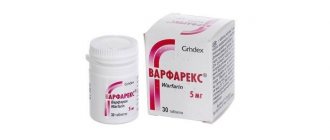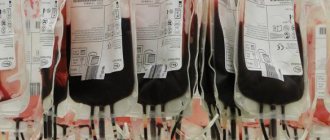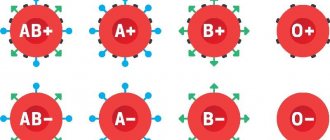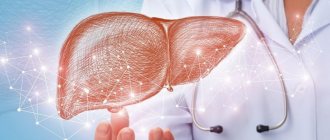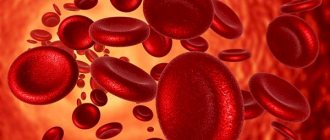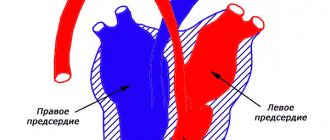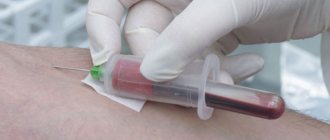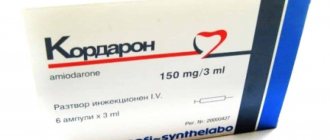ASL-O in the blood: what is it, why is it elevated in children. Joint pain.
Antistreptolysin-O (ASLO, ASO) are antibodies directed at streptolysin, which is an antigen of group A β-hemolytic streptococcus (GABHS), which settles on the skin and mucous membranes of the human body.
This laboratory test is of great practical importance due to the particular “harmfulness” (the ability to have pyogenic properties) of a particular type of microorganism (Streptococcus pyogenes) belonging to the genus Streptococcus. These small spherical bacteria (cocci) were discovered at the end of the 19th century, but to this day, having settled in the human body, they cause great, often irreparable, harm to their “host”.
Detailed description of the study
Streptococci are microorganisms that can cause a wide range of diseases in humans, from local skin lesions to sepsis (blood poisoning). They cause sore throat, pharyngitis and scarlet fever, which is more common in children.
Among this group of bacteria, group A streptococci are the most dangerous: they produce a toxin that destroys blood cells. The advent of antibiotics made it possible to effectively treat this infection. But there are types of streptococci that are resistant to antibiotic therapy. The atypical or mild course of the disease also leads to the fact that treatment is selected late or not prescribed at all.
Ineffective treatment of streptococcal infections can have negative consequences that appear some time after recovery. Both adults and children have an increased risk of developing acute rheumatic fever (ARF) and post-streptococcal glomerulonephritis. The reason for such complications is the similarity of bacterial particles and some cells of the body, due to which the immune system attacks not only the infectious agent, but also destroys the human body.
With ARF, there is an increase in body temperature, migrating joint pain, heart damage and the appearance of subcutaneous nodules. Poststreptococcal glomerulonephritis is an inflammation of the kidneys with impaired function.
In the process of fighting streptococcal infection, immune cells produce antibodies against the bacterial toxin streptolysin-O. Such antibodies in the body are called “antistreptolysin-O” (ASLO). Their presence serves as a marker of recent streptococcal infection.
ASLOs are produced about a week after the initial streptococcal infection. Their titer reaches its maximum values 3-5 weeks after the disease, and then decreases, but can remain detectable for several months. It is most informative to carry out this analysis several times to monitor the dynamics of the antibody titer.
Indications for blood testing for antistreptolysin O
For diseases such as:
- Scarlet fever;
- Erysipelas;
- Tonsillitis (tonsillitis);
- Pyoderma is a purulent lesion of the skin;
- Rheumatic fever;
- Glomerulonephritis - damage to the glomeruli...
Even a year after you have been cured, you must be retested for antistreptolysin - O. This is done to make a more accurate diagnosis, as well as to exclude the possibility of relapse.
A blood test for ASLO should be taken for: arthritis, arthrosis, back pain, pharyngitis, sore throat, laryngitis, tracheitis, pharyngitis, scarlet fever, erysipelas, rheumatism, glomerulonephritis, myocarditis...
References
- Atlas of medical microbiology, virology and immunology / ed. A.A. Vorobyova, A.S. Bykova. - M.: Medical Information Agency, 2003. - P. 37.
- Prevention of streptococcal (group A) infections. Federal clinical guidelines, 2013 - 43 p.
- Clinical recommendations (treatment protocol) for providing medical care to children with tonsillitis (acute streptococcal tonsillitis), 2015. - 29 p.
- Levanovich, V.V., Bannova, S.L., Timchenko, V.N. Evolution of streptococcal infection. Guide for doctors. - SpetsLit., 2015. - 495 p.
- Kanwal, S., Vaitla, P. Streptococcus Pyogenes. — In: StatPearls, 2021.
- Lab Tests Online: website. Antistreptolysin O (ASO), 2021. - URL: https://labtestsonline.org/tests/antistreptolysin-o-aso.
Preparing for a visit to the laboratory
To obtain the most accurate results, donating blood for ASLO requires preparation:
- Last meal 8 hours before;
- After undergoing antimicrobial or antibacterial therapy, at least 3 weeks must pass;
- Limit medication intake on the eve of blood donation;
- Within 24 hours, reduce sweet, salty, spicy, flour and meat from the diet;
- Stop drinking alcohol within 7 days
- To monitor the dynamics of the development of the disease, blood donation for ASLO is carried out 2 times with a break of 7 days, that is, 1 time per week.
Carrying out analysis
No separate events are required. Antistreptolysin O is assessed as part of a standard biochemical blood test.
The procedure is carried out as follows:
- The patient comes to the laboratory. As a rule, the technique requires the collection of biomaterial in the morning. Between 7 and 9 o'clock. This is the best moment, since there are still no changes that could hinder the research and distort the picture.
- In addition, diagnosis must be done on an empty stomach. It is easiest to conduct such a study in the morning.
- Blood is drawn in an amount of 5 ml from a vein.
- After this, the tube with the collected material is labeled with the patient’s name and/or serial number and sent for a profile assessment by a laboratory specialist.
The activities are considered routine. They are carried out in most clinics under the compulsory health insurance policy.
It can also be paid, the cost is minimal. From 300 to 800 rubles in Russia (in the regions the price is lower than in Moscow and St. Petersburg).
Treatment methods
{banner_banstat9}
ASLO in the blood indicates the fact of infection with streptococcus. But this is not enough. After a specific diagnosis has been established, therapy is prescribed. There are many options here. However, the basis is always identical.
- Antibiotics are used. Those to which the microorganism is sensitive. The group is determined only after this; without bacteriological culture, correction makes no sense and is doomed to failure.
- Anti-inflammatory drugs of non-steroidal origin have the ability to partially restore the condition. But they cannot be used for a long time. Including due to blurring of the laboratory picture.
- If the pharynx is affected, antiseptic solutions are prescribed. Based on Chlorhexidine, Miramistin, Lugol and other names. For irrigation, rinsing, lubricating.
- Subsequent administration of immunomodulators is possible. To stimulate the body's defenses.
The course is adjusted as necessary.
ASL-O in the blood: norm and pathology
To prevent beta-hemolytic streptococcus from harming the body of its carrier, it must be detected and destroyed in time. To do this, scientists have developed a research method that makes it possible to determine ASL-O in the human body. It makes it possible to detect antibodies to beta-hemolytic streptococcus in the blood, which confirms its presence in the body.
Normal antibody titres may vary slightly depending on the specific laboratory, but the average values are as follows:
- If the child is under 14 years of age, then the values should not exceed 150 U/l.
- For people over 14 years of age and for an adult, this figure should not exceed 200 U/l.
Most often, a litmus test is used to identify a pathogenic microorganism, which is easy to use. It is completed quickly and does not require financial costs. This method makes it possible not only to determine the presence of antibodies to bacteria, but to determine their titer. For this purpose, the kit contains special reagents. However, some scientists still prefer turbodimetric research, although it is more expensive and requires special instruments.
How does the indicator increase over time?
Based on the results of the study, the essence of the violation is specified. If ASLO is higher than normal, the following variations are possible:
- Absence of any abnormalities in antibody levels. Typically indicates normal health. But not always. During the acute period of infection, an increase in the concentration of antistreptolysin-O is not observed.
This condition persists for at least 1 week, plus or minus a few days. Therefore, this technique is not suitable for diagnosing acute streptococcal lesions.
If symptoms are present, even if ASLO levels are normal, the possibility of a disorder should be considered until proven otherwise.
- After 1-2 weeks, the subacute phase begins. This period is accompanied by a gradual increase in the concentration of antistreptolysin, depending on the individual characteristics of the organism, we are talking about certain numbers.
- Antibodies reach their maximum peak levels in a month or a little less. During this period, the body has already learned to fight the pathological process and suppress streptococci. We can say that this phenomenon indicates a borderline state.
- After a few months, up to six months from the moment of infection and the development of the first symptoms, a moderate decrease in the indicator occurs. The patient returns to normal, there are practically no manifestations. There is a chronic phase of damage to the body.
This moment still suggests the possibility of complete restoration, healing. But the chances of completely eliminating the infection are already much lower compared to previous periods.
At the same time, similar indicators persist during treatment. In such a situation, they speak of a variant of the physiological norm.
- Within 6-8 months from the beginning of the process, a persistent further decrease in the level of antistreptolysin is noted. There is a gradual recovery.
- Towards the end of the first year from the moment of the infectious disorder, the indicator returns to normal.
Depending on the situation, levels may be restored faster, but recovery may also occur less quickly. Discrepancies need to be taken into account.
Additional examinations
Auxiliary diagnostic methods are prescribed without fail, but not to establish the fact of streptococcal infection (this is precisely established through an ASLO blood test), but as part of identifying the exact localization of the bacterial focus and the severity of the lesion.
Among the methods:
- Oral questioning of the patient. It is imperative to identify all health complaints; it is important not to miss anything. The clinical picture provides a lot of information about all aspects of the current pathological process.
- Anamnesis collection. Under what conditions the infection is believed to have occurred and for how long ago.
- Visual assessment of the pharynx. This is the job of an otolaryngologist. Based on the results, the ENT doctor can diagnose pharyngitis, tonsillitis or other lesions of the upper respiratory tract.
- Chest X-ray. To exclude pneumonia and bronchitis, which often develop upon contact with pyogenic flora.
- A throat swab with further bacteriological culture is required. This will confirm the infection with streptococcus and also detect the sensitivity of the pyogenic bacterium to a certain drug or antibiotic.
- Assessment of joint condition.
- Basic neurological examination. Study of reflexes.
Also other methods, as needed. The issue is resolved based on the specific situation.
Interpretation of results and presumptive diagnoses
Doctors have the opportunity to examine changes and suggest a particular diagnosis based on the nature of the deviations in the level of antistreptolysin-O.
The following probable finds are identified:
- Increasing concentration by 4-6 times. Accompanies an infection suffered in the recent past. This is the period following the acute condition. With systematic treatment, the numbers are approximately at the same level, only the time they remain is different.
- An increase in ASLO by 1.5-2 times means chronic infectious and inflammatory processes. There is a constant, recurrent course of the disorder or carriage of streptococcus. Depending on the results of other studies, doctors decide on treatment tactics.
- Absence of any dynamics in the concentration of antistreptolysin-O for at least 6 months. Speaks of the development of an autoimmune secondary lesion. This is usually rheumatism or arthritis of non-septic origin. Targeted diagnostics are required.
With all that said, normal levels do not indicate the absence of an infectious disorder.
Attention:
It is necessary to conduct the study several times with an interval of a couple of weeks to obtain dynamic results and a complete picture of the pathological process.
But even this does not guarantee a clear outcome. Since in approximately 10-30% of situations there are no deviations for a long period of time, even with an active infection.

